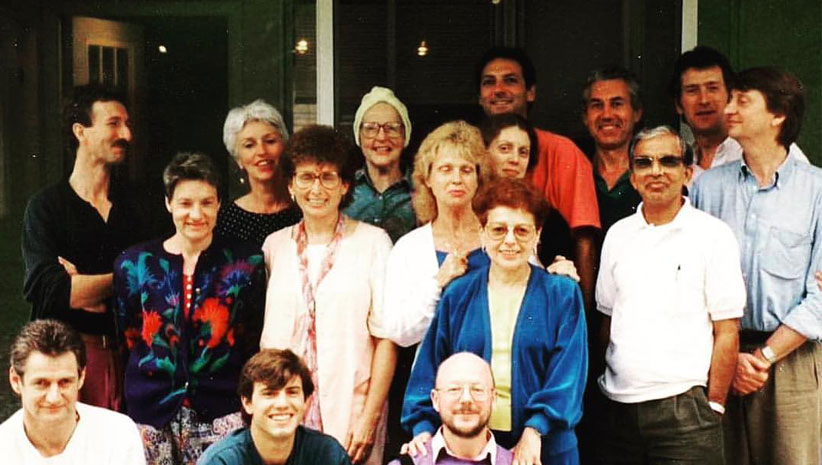
A group of TKV Desikachar’s students gather around him.
Yoga pioneer TKV Desikachar died Monday August 8 in Chennai, India. He was 78 years old. May his family find peace in his passing.
His wife Menaka Desikachar has been a gracious tower of strength, nurturing her family and ailing husband while strenuously upholding the continuity of teaching for the community of his students.
Desikachar devoted his life to studying and teaching the practice of Yoga that his father, Professor T Krishnamacharya, had brought forth from the Great Tradition. Krishnamacharya was a renowned scholar and yogi in India. From my point of view, we would not have had the same access or ability to understand his teaching in a modern context without the clear and precise interpretation from Desikachar.
At the tender age of 27, Desikachar witnessed a western woman ran across the font yard to hug Krishnamacharya with an unusual (for India) public display of profuse gratitude, because Krishnamacharya had healed her of a debilitating illness. To see a woman embrace an austere Brahman man in public was indeed a rare sight in India. That day Desikachar gave up a bright and promising engineering career with a German company because he had witnessed the power and importance of his father’s work.
Many years later Desikachar visited this same elderly lady, Kay Malvenan at her home in Wellington, New Zealand to thank her for inspiring him to yoke to his father’s teaching. It was an auspicious meeting between dear friends.
The hallmark of Desikachar’s communication is that there is a right yoga for every person. Yoga is adapted carefully to individual needs according to body type, age, health and, also importantly, cultural background. When this is done, yoga facilitates direct intimacy with life and reality itself—the power of this cosmos that brought us here in the first place and presently nurtures us as pure intelligence and utter beauty.
“Anyone who can breathe can do yoga,” said Desikachar. “It is the practical means by which the ideals of an inspired life can be actualized.”
Because of Desikachar’s brilliance yoga is perfectly adapted to every kind of student. His engineering science allowed him to he refine the ancient teaching tenant that yoga must be made relevant to every student. Desikachar attributed his ability to understand his western students to the influence of the two Krishnamurtis, J and UG, who were his close family friends. Desikachar said of Jiddu Krishnamurti (who studied diligently with him), “his profound respect for the teaching and the teaching relationship helped me become a good student of my own father. He also helped me understand everything about the West. He helped me eat with a knife and fork!” These were important collaborations between sincere friends that will forever give the world a clear view of yoga, unhinged from yoga business, power structures, and exaggeration.
Like his father, Desikachar was a humble man committed to the accurate delivery of the Great Tradition without the empire building that can cloud the picture in yoga and spirituality. Krishnamacharya was a Yoga master abut never a yoga entrepreneur. In 1998 Desikachar even dissolved the name Vini Yoga that was forming around his teaching. He did not want his father’s scholarship to be identified as just another style. Desikachar was determined to communicate that in yoga is not, ”one size fits all.” The one brand of relevant yoga for him is that of capital Y, Yoga, which is adapted to the needs of every person.
When the principles of the Great Tradition are added to the popular styles it makes yoga entirely your own, efficient, powerful, and safe. Desikachar had a unique ability to truly respect all people and have each person actually feel seen—which is another ancient tenant of yoga teaching. He allowed each person to feel the truth or the answers to their questions to come bubbling forth as their own experience and revelation, rather than confusing students with ideas and ideals that are not relevant or out of their reach.
In the early 1990s, I was involved in a book project for Desikachar with the intention to increase the availability of his father’s teaching around the world. I was calling the book The Art of Yoga. One day while walking on Adyar Beach, Desikachar suddenly declared, “The Heart of Yoga is the correct title!”
Desikachar later explained that the heart of yoga is the relationship between student and teacher. The mutual affection between two actual people is the universal means of wisdom transmission. No more than a friend, no less than a friend. Desikachar wanted to spread throughout the world with the understanding that the best teacher is often someone from your own culture because he or she understands you the best.
When I showed him The Heart of Yoga in 1995, I observed quiet tears. He said, “I wish my father had seen this book. He did not see the worldwide effect of his work in his lifetime. But now he does.” The Heart of Yoga is Desikachar’s gift; it includes his father’s commentary on the Yogasutra of Patanjali, the ancient text that defines yoga. The Heart of Yoga has been translated into many languages and has become a source text for yoga today. His life lives on. Desikachar is a treasure forever.
